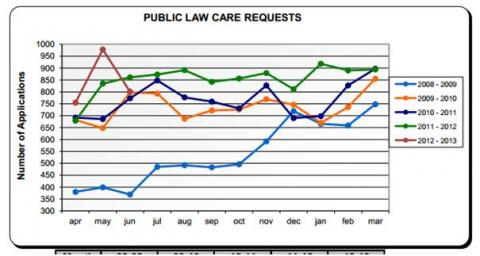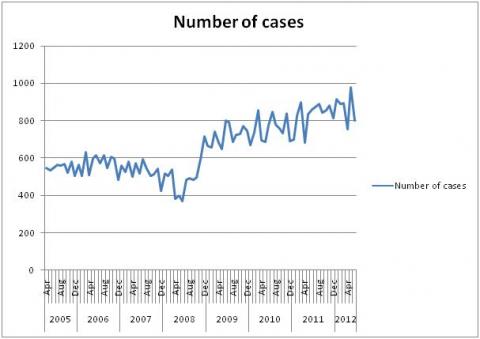Is the case of Baby P still driving a rise in applications to take children into care?
Reporting yesterday on the release of the General Medical Council's (GMC's) new guidance for doctors on reporting child abuse, the Guardian cited some interesting statistics on the rising number of children taken into care.
In fact, according to the article the number of applications to the courts by local councils to take a child into care is at an "all time high".
The paper wrote:
"There were 1,727 applications in April and May in England alone — 14.1% higher than the same months in 2011 — and an all-time high of 972 in May alone."
These statistics are interesting in themselves, but as the Guardian only provides a snapshot of two months in 2010 and 2011, we can't tell how this relates to the bigger picture over a longer period of time.
The source of the Guardian's claims can easily be traced to the monthly care demand figures published by the Children and Family Court Advisory and Support Service (Cafcass).
Cafcass is the non-departmental public organisation appointed by the court to look after the interests of children in family court proceedings.
Looking at Cafcass's care demand statistics for May 2012, we can see that the Guardian has accurately reported the figures:

Cafcass's statistics are pulled from its national case management system (CMS), and each "case" can involve several children and multiple forms of application.
However, a day before the Guardian article was published, Cafcass released its updated statistics for June 2012. In this latest report, the total number of cases brought in the most recent quarter was recorded as being only 6.7 per cent higher than for the same period last year.
This suggests a more moderate increase in relative monthly case demands once the figures for June are taken into account.
In fact, if we consider Cafcass's graph displaying the number of applications per month over several years, we can see that the latest figures reveals a dip in the number of applications in June 2012 compared to June 2011.

To get a greater sense of how much the number of applications by local authorities have increased over time, we would need to look beyond just two or three months per year. How have Cafcass's case demands changed over time?
Cafcass provides data on case demands each month from April 2005, and the graph below outlines the figures from this point to June 2012:

The data suggests that prior to November 2008, the number of applications per month had been moderately decreasing, but between November and December 2008, there was a sharp increase of just over 120 cases in a single month.
Since this spike in cases, there has been a greater variation from month to month, but the number of cases has been generally edging upwards, despite the drop reported in June 2012.
Overall, the data supports the Guardian's hypothesis that the high-profile court case brought in September 2009 after the death of 'Baby P' might be behind the growth in recent years.
In fact, as Cafcass itself notes, the rapid increase of cases at the end of 2008 correlates with the publication of the Baby Peter Serious Case Review Executive Summary by the Haringey Local Safeguarding Children's Board in November 2008.
The publication of this Summary sparked intense criticism of the quality of child protection in the London Borough of Haringey (which was responsible for Peter Connelly's care).
But is the legacy of Baby P's case still responsible for keeping care applications at relatively high levels?
After noting the sharp increase in care demands received after the case of Baby P, Cafcass commissioned two surveys to examine the reasons for the spike.
Notably, the "Baby Peter Effect" was still reported prevalent in the second survey, which was conducted this year.

However, this was not the only or even the most frequently mentioned reason behind care applications.
"Local Authority practice" in one way or another was the reason most oft cited for the increase in care applications.
Guardians also recognised that local authority's legal departments are generally issuing proceedings more promptly after they've been notified of a case by the children's services; that children's services are providing more robust risk assessment of cases; and social workers were more aware of the negative impact certain elements of a homelife, such as neglect and domestic abuse, can have on a child's development.
According to Cafcass' survey, therefore, the case of Baby P is still certainly a prevalent factor in the sustained high levels of applications to take children into care, but this is part of, and perhaps a trigger of, a greater trend of widespread improvement amongst local authority services.